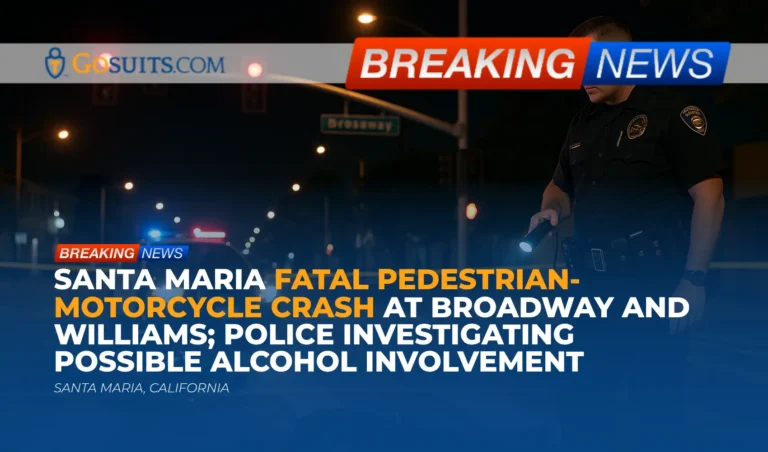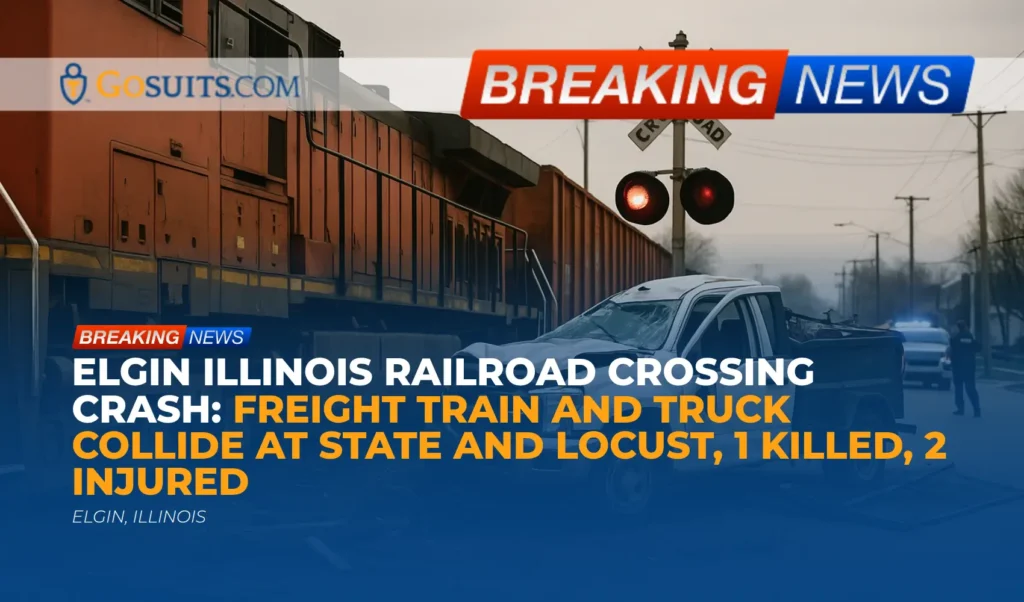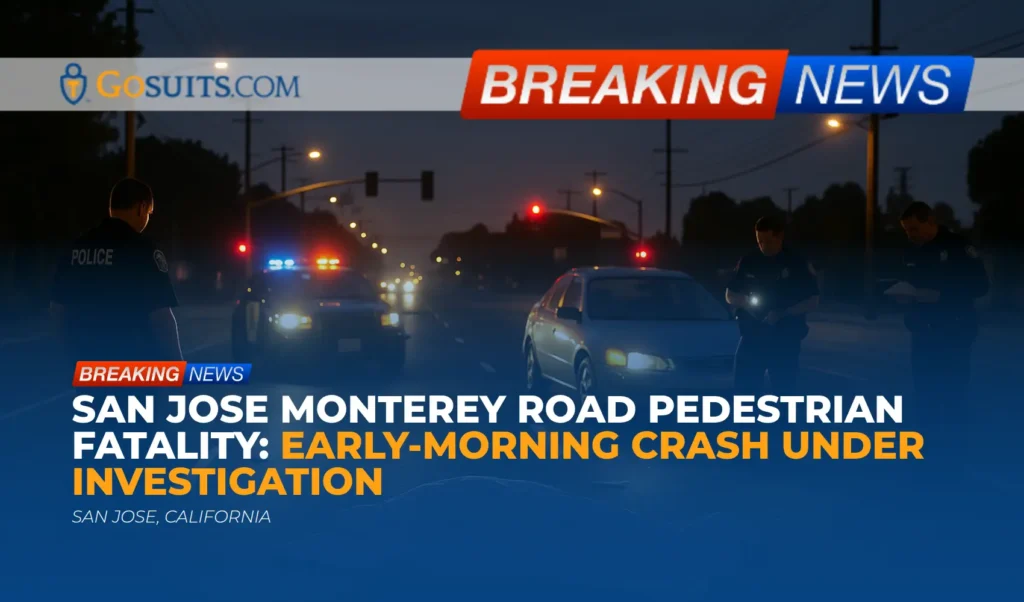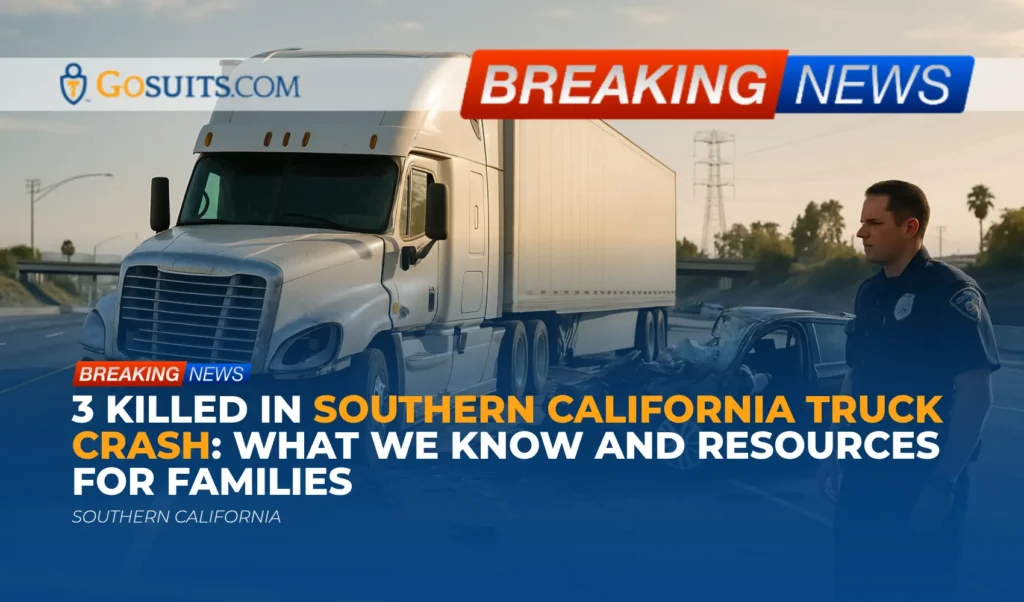- Incident overview and known facts
- Location, timing, and official statements
- What early evidence suggests about fault and liability
- Steps families often take after a fatal pedestrian collision
- Insurance and claims considerations
- Preserving and building evidence
- Safety and prevention context
- Who may bring civil claims in California after a fatal collision
- Practical resources and contacts
- Commentary from Gosuits Santa Maria, California Personal Injury Attorney
- Action steps to consider now
Incident overview and known facts
According to information provided by local media based on statements from authorities, a motorcycle and pedestrian collided at the intersection of Broadway and Williams Street in Santa Maria on the evening of Saturday, October 18. First responders from Santa Maria Police, the Fire Department, and emergency medical services arrived shortly after 8:35 p.m. and found two men in the intersection with significant injuries. The pedestrian, age 25, and the motorcyclist, age 32, were transported to Marian Regional Medical Center. The pedestrian later passed away from his injuries. The motorcyclist sustained serious injuries and remains under medical care. Preliminary information from the Santa Maria Police Department’s Traffic Unit indicates alcohol may have been a factor in the collision. The investigation is ongoing. Witnesses were asked to contact Officer Medrano at 805-928-3781, extension 1139.
As reported, the pedestrian was crossing eastbound in the north crosswalk of Williams Street when he was struck by a motorcyclist traveling northbound on Broadway. The initial impact ejected the motorcyclist and threw the pedestrian into the roadway. Details such as traffic signal phase at the moment of impact, vehicle speed, and visibility conditions have not been released at this time.
We share this summary to help the community understand what is known so far. We are mindful that a family is grieving, another person is badly injured, and many people may be processing what happened.
Location, timing, and official statements
Location: Intersection of Broadway and Williams Street, Santa Maria, California.
Timing: Saturday night, October 18, approximately 8:35 p.m.
Official statements: The Santa Maria Police Department has indicated that alcohol may have been a factor and that the Traffic Unit is conducting the investigation. Inquiries and information can be directed to Officer Medrano at 805-928-3781 ext. 1139. No further official details about right-of-way, speed, or the status of traffic controls have been publicly released as of the initial report.
What early evidence suggests about fault and liability
It is too early for definitive conclusions about fault. In California, liability in traffic collisions is determined by the specific facts, physical evidence, witness accounts, and applicable law. The following legal principles often come into play in pedestrian collisions at intersections. These principles are general information and not a determination for this case.
California crosswalk duties and right-of-way
California law requires drivers to yield the right-of-way to pedestrians crossing within any marked crosswalk or within any unmarked crosswalk at an intersection. Drivers must exercise due care and reduce speed or take other actions as necessary to safeguard a pedestrian’s safety. Pedestrians also have duties to use due care and avoid suddenly leaving a curb in a way that creates a hazard. See California Vehicle Code section 21950 for these balanced duties for both drivers and pedestrians CVC 21950.
Where pedestrian signal indications are present, pedestrians must comply with the applicable signal displays, and motorists must obey traffic signals as well. See California Vehicle Code section 21456 regarding pedestrian signals CVC 21456. The specific signal indications and timing at the time of this collision have not been released, and any assessment would require access to official reports, signal timing records, and physical evidence.
Effect of suspected impairment
Authorities indicated that alcohol may have been a factor in this collision. In civil cases, violation of a safety statute can be evidence a jury may consider to find negligence under the doctrine often referred to as negligence per se. California Evidence Code section 669 describes when failure to exercise due care by violating a statute may create a presumption of negligence if certain conditions are met Evidence Code 669. Whether impairment occurred and whether any statutory violation took place are factual questions determined by the evidence, including toxicology results, officer observations, and additional investigation.
Comparative fault in California
California uses a pure comparative negligence system. Multiple parties can share responsibility, and any damages may be reduced by a party’s percentage of fault. Even if a pedestrian is found to have some degree of fault, recovery can still be possible, proportionate to the other party’s responsibility. This system relies on a careful review of all circumstances, including road design, lighting, traffic controls, speed, visibility, and actions of the involved individuals.
Potentially responsible parties
Depending on the facts, the following parties may be evaluated for potential civil responsibility:
- Motorist for vehicle operation, speed, impairment, attention, and yielding duties.
- Pedestrian for compliance with signals and due care obligations, if relevant.
- Public entity if a dangerous condition of public property contributed to the collision, such as deficient lighting, malfunctioning signals, or sight obstructions. Claims against public entities follow special deadlines under the California Government Claims Act, discussed below.
Steps families often take after a fatal pedestrian collision
When a fatal collision occurs, key information and documents can help families understand what happened. Here are practical steps and points of contact commonly involved. Availability and timing can vary based on the status of the investigation.
Police traffic collision report
Contact the Santa Maria Police Department to request the traffic collision report, once available. Investigations can take time, and interim reports may not be released while active. For witness information or to share tips, contact Officer Medrano at 805-928-3781 ext. 1139 as publicly requested. If you plan to pursue a claim, consider consulting an attorney before discussing the facts with any insurance company. What is said to insurers can be recorded and used later.
Coroner and autopsy information
In California, the county coroner investigates deaths due to external means such as vehicle collisions. Government Code section 27491 outlines the coroner’s duties to inquire into such deaths Gov. Code 27491. Next of kin can typically request copies of the coroner’s report and toxicology when available. Toxicology testing can take several weeks. Contact the County Coroner’s Bureau through the Sheriff’s Office for request procedures and estimated timelines.
Medical records from the hospital
Loved ones may request medical records from Marian Regional Medical Center for the care provided. Hospitals require proper authorization, and where the patient has passed away, next of kin or a personal representative may need to provide proof of authority. Consider preserving all discharge summaries, billing statements, and itemized charges, as these records can be important for later insurance claims.
DMV accident reporting
California requires that any traffic collision involving injury, death, or property damage above a statutory threshold be reported to the DMV using Form SR-1 within 10 days, regardless of fault. More information and the SR-1 form are available from the California DMV DMV accident reporting requirements. Filing is a separate obligation from obtaining the police report.
Victim support and compensation services
The California Victim Compensation Board offers financial assistance for eligible victims and family members for certain expenses, such as funeral costs and counseling, under program rules. Learn more at the official state site California Victim Compensation Board.

Public records and traffic signal data
If questions arise about roadway design, signage, or signal function, families sometimes seek records such as signal timing sheets, maintenance logs, lighting plans, or prior collision history. In California, public records may be requested under the California Public Records Act. The Attorney General provides a summary of the Act and how to request records from public agencies California Public Records Act overview. For a potential public entity claim, early requests can help preserve evidence.
Scene preservation and video
Time is critical. Businesses, residential cameras, and transit vehicles near the intersection may have relevant footage. Many systems overwrite within days. Documenting roadway marks, debris fields, and lighting conditions as soon as safely possible can be helpful. Where practical, preserve the pedestrian’s personal effects and footwear, and the motorcycle’s condition before repairs, as they may be inspected by experts during a civil investigation.
Insurance and claims considerations
Insurance issues can be complex after a fatal collision. The following points are provided for general education. Before speaking with any insurer, consider consulting an attorney first to understand rights and obligations. Statements to insurers can be recorded and may affect a future claim.
- Liability insurance of the motorcyclist: If the motorcyclist is found at fault, a wrongful death claim may be asserted against their liability coverage, subject to policy limits and defenses.
- Uninsured or underinsured motorist coverage: If the at-fault party has no insurance or insufficient limits, the decedent’s own auto policy or a resident relative’s policy may include uninsured or underinsured motorist coverage that can apply to pedestrian collisions. Policy language governs scope and eligibility.
- Medical payments coverage: Some auto policies include optional medical payments coverage that may assist with medical costs, regardless of fault, though terms and offsets vary.
- Health insurance and subrogation: Health insurers that pay medical bills related to the collision may assert reimbursement rights from any third-party recovery, depending on plan type and applicable law.
- Wrongful death and survival actions: California recognizes two separate civil claims. Wrongful death claims are for eligible survivors’ losses, while survival actions allow the decedent’s estate to pursue certain claims the decedent could have brought had they lived. See Code of Civil Procedure sections 377.60 and 377.30.
- Deadlines: In California, the general statute of limitations for wrongful death is two years from the date of death CCP 335.1. If a public entity may be involved due to a dangerous roadway condition, a government claim must usually be filed within six months of the incident as a prerequisite to a lawsuit Gov. Code 911.2.
Insurance adjusters may request recorded statements, medical authorizations, or quick settlements. It can be prudent to understand the full scope of losses, policy limits, and potential future impacts before agreeing to any release.
Preserving and building evidence
Thorough civil investigations often draw on many sources of information. The following evidence categories are frequently relevant in pedestrian collisions.
- Traffic collision report and supplemental diagrams: Officer narratives, scene diagrams, and measurements can shed light on points of impact, sight lines, and final rest positions.
- Witness statements: Independent accounts from drivers, passengers, nearby pedestrians, or residents can help confirm movement and timing sequences.
- Traffic signal and lighting data: Signal timing charts, phase logs, maintenance records, and lighting photometrics can inform visibility and right-of-way issues.
- Video and still images: CCTV from businesses, buses, rideshares, residential doorbell cameras, and traffic cameras can provide crucial frames. Prompt preservation requests are key due to short retention periods.
- Physical evidence: Skid or yaw marks, scrape marks, debris fields, and damage profiles on the motorcycle can help reconstruct speed and orientation.
- Medical and coroner records: Hospital treatment records and coroner findings, including toxicology and injury pathophysiology, may be used to determine impact mechanics and timing.
- Phone and device data: With appropriate legal process or consent, device location and usage logs may inform distraction or movement at the time of the collision.
Because some of these records are controlled by public agencies or third parties, timely requests and preservation letters can make a significant difference in what evidence remains available.
Safety and prevention context
Nighttime conditions, higher travel speeds, and impairment are frequently associated with severe pedestrian outcomes. National and state public safety sources emphasize these risk factors as persistent contributors to serious harm.
- National pedestrian safety: NHTSA highlights that drivers must be vigilant for people walking, especially at night and in urban areas. See federal guidance on pedestrian safety from the National Highway Traffic Safety Administration NHTSA pedestrian safety.
- Alcohol involvement: The Centers for Disease Control and Prevention note that alcohol is involved for drivers and or pedestrians in a large share of fatal pedestrian crashes nationwide. See CDC pedestrian safety overview CDC pedestrian safety.
- California trends: The California Office of Traffic Safety publishes statewide data and emphasizes the vulnerability of people walking and the importance of safe speeds and yielding behavior. See OTS statistics overview California OTS statistics.
- Visibility at night: The Federal Highway Administration provides resources for improving pedestrian visibility and lighting at crossings, underscoring how illumination affects detection distance. See FHWA pedestrian safety resources FHWA pedestrian and bicycle safety.
While these general trends cannot answer the specific questions about this collision, they offer context for why precise investigation into speed, lighting, impairment, and right-of-way is so important in determining how and why severe injuries occurred.
Who may bring civil claims in California after a fatal collision
California allows certain family members and the decedent’s estate to pursue civil claims arising from a fatal collision. The two primary pathways are wrongful death and survival actions. This section is general information about the legal framework.
Wrongful death
Wrongful death claims are brought by specified survivors for their own losses, which may include loss of the decedent’s financial support, household services, companionship, and related harms. Entitled claimants are listed in Code of Civil Procedure section 377.60, which includes a spouse, domestic partner, children, and sometimes others who were dependent on the decedent, as defined by the statute. See CCP 377.60.
Survival action
A survival action belongs to the decedent’s estate and seeks damages the decedent could have recovered had they survived, such as certain economic losses between injury and death and, in some circumstances, punitive damages if legally justified. The estate’s personal representative or successor in interest prosecutes this claim. See CCP 377.30.
Deadlines and notice
As noted earlier, most wrongful death claims in California have a two-year statute of limitations from the date of death CCP 335.1. If a public entity may be implicated by a dangerous condition of public property claim, a government claim generally must be filed within six months Gov. Code 911.2. These deadlines are strict, and evaluating which deadlines apply requires a review of the facts.
Practical resources and contacts
Below are practical points of contact and official resources that are commonly relevant after a serious collision in Santa Maria. Availability and contact details can change, so calling ahead is advisable.
- Santa Maria Police Department: For witness information, tips, or to inquire about the traffic collision report, contact Officer Medrano at 805-928-3781 ext. 1139 as requested in the public notice. Records units often have formal procedures and timelines for report release.
- Santa Barbara County Coroner’s Bureau: The Coroner investigates collision fatalities in the county. Next of kin can request coroner and toxicology reports when available. Refer to the coroner’s authority under Gov. Code 27491 and contact the Sheriff’s Office to be directed to the Coroner’s Bureau for request steps and any required documentation.
- California DMV: File the SR-1 crash report within 10 days if required. Information and forms are available here: DMV accident reporting requirements.
- California Victim Compensation Board: Families may explore eligibility for assistance with certain expenses. See the state program site: California Victim Compensation Board.
- Public records requests: For traffic signal timing, maintenance records, lighting plans, or prior collision history related to the intersection, public records requests can be made to the appropriate agency. The California Attorney General provides a plain-language overview of the Public Records Act process: California Public Records Act overview.

Commentary from Gosuits Santa Maria, California Personal Injury Attorney
Our hearts go out to everyone affected by this tragic collision in Santa Maria. A young life has been lost, and another person is seriously injured. This commentary is intended for educational purposes and general information to help community members understand the civil considerations that often arise after a severe crash.
At an intersection crosswalk, the law places responsibilities on both motorists and pedestrians, with a clear emphasis on drivers exercising due care to safeguard people walking. When impairment is suspected, it raises serious concerns about safe operation and the potential for civil liability if the evidence supports a statutory violation and causation. At the same time, a fair assessment must look at the entire picture, including signal indications, lighting, speed, and visibility. Thorough, methodical investigation is essential before assigning fault.
Insurance companies and corporations that insure drivers often move quickly after a fatal collision. Adjusters may ask for recorded statements, broad medical authorizations, or early settlements before the full scope of harm is understood. Those approaches can capitalize on the shock and grief that follow a tragedy, and they may limit later recovery if signed without complete information. Taking time to understand the policy language, available coverages, and applicable deadlines can help protect a family’s rights.
A free consultation with a seasoned injury attorney can be an important step to understand options, timelines, and potential sources of recovery in plain language. It costs nothing to learn what deadlines apply, what evidence should be preserved now, and how communications with insurers can be managed to avoid missteps.
Action steps to consider now
In the days and weeks after a serious pedestrian collision, critical information can be lost and important deadlines can approach quickly. The following are practical steps people commonly consider to protect their interests and preserve clarity about what happened.
- Request and preserve official records: Ask the investigating agency when the traffic collision report will be available and what the process is to obtain it. Note the report number if provided and keep all correspondence. Preserve any notifications from the coroner and hospital records related to care and billing.
- Secure video and scene documentation: Identify nearby businesses, residences, and transit routes that might have cameras facing the intersection and ask that footage be preserved. Photograph the area, including crosswalk markings, lighting, sight lines, and any nearby construction or obstructions.
- Collect witness information: Write down names, addresses, and phone numbers for anyone who saw the collision or its aftermath. Memories fade quickly, and early contact can make a difference.
- Be cautious with insurer communications: Before making statements to any insurance carrier, consider speaking with an attorney to understand rights and obligations. Recorded statements can be used in later proceedings.
- Calendar critical deadlines: Note the two-year wrongful death limitation period in California and the six-month government claim deadline if a public entity may be implicated. Missing these deadlines can restrict legal options.
- Evaluate all possible insurance coverages: Review the decedent’s auto policy, any resident relative policies, and relevant health insurance plans for benefits that may apply, such as uninsured motorist or medical payments coverage.
- Consider public records requests: For questions about signal timing or lighting, pursue public records from the responsible agency. Early requests can secure key technical information before routine data overwrites occur.
- Use available state resources: Explore California Victim Compensation Board resources for potential financial help with funeral costs and counseling while other claims are evaluated.
Acting promptly can help preserve evidence, clarify what happened, and keep options open under California law. When uncertainty exists, obtaining a free, no-obligation consultation with a skilled injury attorney is a straightforward way to get oriented before taking further steps.
References to official sources
The following government and academic sources provide the laws and public safety information referenced above:
- California Vehicle Code 21950 Right-of-way in crosswalks.
- California Vehicle Code 21456 Pedestrian signals.
- California Evidence Code 669 Negligence per se framework.
- California Code of Civil Procedure 377.60 Wrongful death.
- California Code of Civil Procedure 377.30 Survival actions.
- California Code of Civil Procedure 335.1 Two-year limitation period for wrongful death.
- California Government Code 911.2 Government claim deadline.
- California Government Code 27491 Coroner’s duties.
- California DMV SR-1 accident reporting requirements.
- California Victim Compensation Board Program overview and eligibility.
- California Attorney General Summary of the California Public Records Act.
- NHTSA Pedestrian safety resources.
- CDC Pedestrian safety facts and prevention.
- California OTS State traffic safety statistics.
- FHWA Pedestrian and bicycle safety resources.






